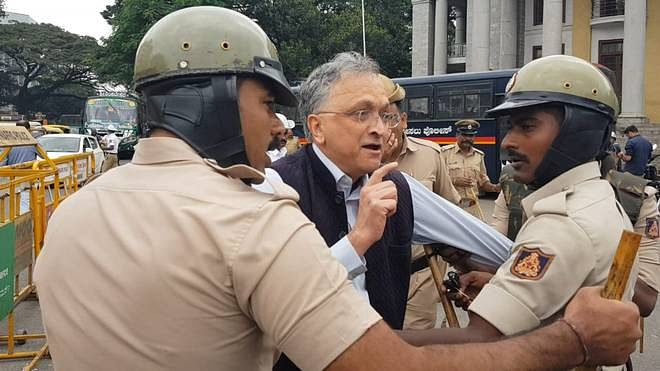When Ramachandra Guha, one of India’s foremost historians and public intellectuals, was dragged and then detained by the Bengaluru Police on 19 December for protesting against the Citizenship Amendment Act, the Twitterverse exploded with outrage.
Academics, journalists, politicians, and even business people expressed shock that an eminent personality like Guha was denied speaking to the press and whisked away by the police. Guha, 61, was accosted mid-sentence, on camera, by a group of policemen who literally dragged him away, even as he nearly lost his balance.
With the video going viral with visuals of his detention being widely telecast on TV channels or shared on social media and WhatsApp groups, Guha became a popular face of the nationwide protests against the CAA and National Register of Citizens (NRC). This is why Ramachandra Guha is ThePrint’s Newsmaker of the Week.
Also read: ‘For how long will you test a Muslim’s patience’ — academics say CAA protests to intensify
Fighting with words
Guha’s early works as a historian revolved around India’s ecology and environment, but he is better known as a biographer of Mahatma Gandhi – and it is here that his antagonism with the Narendra Modi-led BJP government begins. Guha hasn’t shied away from claiming that the BJP has “appropriated” Gandhi to further its own political objectives. The BJP, in turn, has labelled him an ‘Urban Naxal’.
Like most liberal intellectuals, Guha fights his battles more with words than performative action. Before the CAA was passed, for example, Guha wrote op-eds calling it “blatantly communal”, put out tweets likening Home Minister Amit Shah’s push for the law to Muhammad Ali Jinnah’s two-nation theory, and signed petitions demanding that it be revoked.
Guha also made himself heard on TV, where he is greatly sought after by primetime channels and regularly gives interviews criticising the BJP and its version of Indian history. In an interview to NDTV before the citizenship bill became a law, Guha said: “Those who believe fusing religion into State powers and State laws will lead us to a prosperous India needn’t look further than Pakistan.”
Usually, Guha’s dissent is spelled out in the editorial pages of Hindustan Times or The Telegraph or The Indian Express – where personalities like Pratap Bhanu Mehta and Romila Thapar keep him company – rather than on the streets.
Perhaps this is why watching him being yanked away by policemen on the streets finally shook the conscience of India’s educated class.
Guha hitting the streets has shaken up even the BJP, or so it seems, as the party’s Karnataka unit put out a tweet on his detention from its verified handle: “#UrbanNaxals who operate in a Dark World are completely unknown to the Common Man. They make their presence felt through inciting violence & organizing protests at the behest of their Masters. They are getting exposed now.”
Non-violence
After being released, Guha, speaking to NDTV, called the move to impose Section 144, under which he was detained, as “paranoid, fearful and insecure”.
“We have been through difficult times before, like Gandhi’s death, the Emergency in the 1970s, the riots in the 1990s riots. This is the fourth major crisis in the country. We will get out of this but only if we are patient and work in a non-violent way,” he said.
